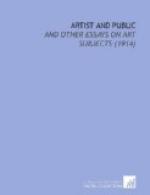But while we talk so loudly of progress in the arts we have an uneasy feeling that we are not really progressing. If our belief in our own art were as full-blooded as was that of the great creative epochs, we should scarce be so reverent of the art of the past. It is, perhaps, a sign of anaemia that we have become founders of museums and conservers of old buildings. If we are so careful of our heritage, it is surely from some doubt of our ability to replace it. When art has been vigorously alive it has been ruthless in its treatment of what has gone before. No cathedral builder thought of reconciling his own work to that of the builder who preceded him; he built in his own way, confident of its superiority. And when the Renaissance builder came, in his turn, he contemptuously dismissed all mediaeval art as “Gothic” and barbarous, and was as ready to tear down an old facade as to build a new one. Even the most cock-sure of our moderns might hesitate to emulate Michelangelo in his calm destruction of three frescoes by Perugino to make room for his own “Last Judgment.” He, at least, had the full courage of his convictions, and his opinion of Perugino is of record.
Not all of us would consider even Michelangelo’s arrogance entirely justified, but it is not only the Michelangelos who have had this belief in themselves. Apparently the confidence of progress has been as great in times that now seem to us decadent as in times that we think of as truly progressive. The past, or at least the immediate past, has always seemed “out of date,” and each generation, as it made its entrance on the stage, has plumed itself upon its superiority to that which was leaving it. The architect of the most debased baroque grafted his “improvements” upon the buildings of the high Renaissance with an assurance not less than that with which David and his contemporaries banished the whole charming art of the eighteenth century. Van Orley and Frans Floris were as sure of their advance upon the ancient Flemish painting of the Van Eycks and of Memling as Rubens himself must have been of his advance upon them.
We can see plainly enough that in at least some of these cases the sense of progress was an illusion. There was movement, but it was not always forward movement. And if progress was illusory in some instances, may it not, possibly, have been so in all? It is at least worth inquiry how far the fine arts have ever been in a state of true progress, going forward regularly from good to better, each generation building on the work of its predecessors and surpassing that work, in the way in which science has normally progressed when material conditions were favorable.
If, with a view to answering this question, we examine, however cursorily, the history of the five great arts, we shall find a somewhat different state of affairs in the case of each. In the end it may be possible to formulate something like a general rule that shall accord with all the facts. Let us begin with the greatest and simplest of the arts, the art of poetry.




